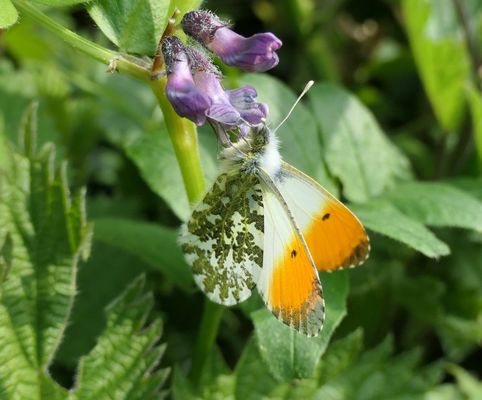YOU have it agree that it’s a glorious view from the summit of Colin Mountain – maybe it’s not as famous as the one from Napoleon’s Nose, but Dúlra prefers it every time. Cave Hill might fill tourists’ Instagram pages, but Colin is west Belfast’s forgotten jewel.
Sunday’s visit was sublime. The late April heatwave saw this windswept hillside bathed in sunshine, the sun’s rays breathing life deep into the soil.
Dúlra took this pic at the summit stone, standing 948 feet above Belfast, with Hannahstown village on the left and most of Belfast sweeping out before him like an unfurled carpet. If you look closely you’ll see Dúlra’s blackthorn stick on the ground at the bottom which he set down to take the photo.
You can lose yourself on a mountain, and Dúlra has done it many times here since he first visited as a kid to fish in the quarry pools. You can let your mind float away on the wind where it can gather up all the sounds and scents and scenery of a deserted paradise.
And if you really want to spoil yourself, you can just let yourself fall among the heather and become part of the mountain itself. When you’re walking, you stick out a mile o birds and animals. Go to ground level and you disappear.
Within a few minutes as Dúlra lay among the heather under the sun, a pair of ravens glided overhead. Then a battalion of house martins swept low over the land, probably just arriving back from Africa.
But the tranquility of Colin Mountain didn’t last long. This hillside is remote and hard to access, which adds to its value as a nature hotspot. But it’s also unregulated and open to abuse.
Scrambler motorbikes roared in the distance. Dúlra had noticed muddy tyre tracks right up to the summit stone. The roaring got louder and in no time they were racing around the summit. These lads were having the time of their life and doing nothing wrong, but it’s hardly conducive to a lazy day birdwatching on a hilltop.
It fact it’s not conducive to birds at all. And it was only then that Dúlra realised that all across the mountaintop, he hadn’t come across any meadow pipits or skylarks, two species that make their home on these remote outposts. In their world, the roar of bikes is one of the most terrifying sounds imaginable.
It was only when you went further down the mountain, closer to Slivenacloy, that the familiar songs of these birds drifted across the landscape once more. Again, Dúlra lay on the grass and focused the bins. A linnet landed on a branch, but while trying to focus on it, Squinter spotted another bird on a far post – a wheatear, a beautiful mountain visitor that had just arrived back from Africa. There were three in total, establishing new breeding grounds after their long journey.
Then a stonechat gave a warning call. Dúlra turned to spot a beautiful demure female on top of a whin bush. He focused – there was a curly caterpillar in her mouth. It may be only April, but this bird was already feeding her chicks.
Dúlra stayed absolutely still, the warning call was because she had spotted him. But if you have the patience to stay rigid for long enough, she’ll think the threat has gone.
There’s a great saying in Irish: is trom cearc i bhfad, even a chicken gets heavy after a time. For chicken, substitute binoculars.
There was cramp in Dúlra’s arms as he held them to his eyes, but he dared not budge. The stonechat darted from whin to bramble, the curly caterpillar still in her mouth. Dúlra followed her every move, hoping she’d lead him to her nest among the undergrowth. Then she darted with the speed of one of those scramblers, so fast that Dúlra couldn’t move the binoculars fast enough. A few seconds later he found her again on top of the whin bush. With no caterpillar.
That lightning dart was to the nest. Dúlra was outsmarted once again.
He’ll be back to lie among the heather. But next time, he might give the summit a miss.
• If you’ve seen or photographed anything interesting, or have any nature questions, you can text Dúlra on 07801 414804.







